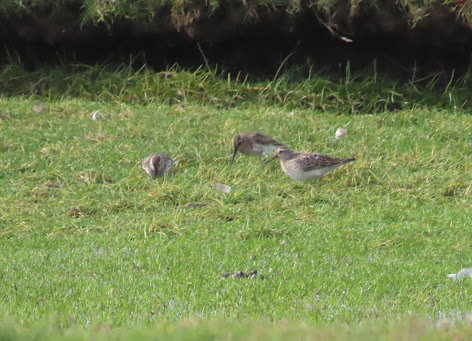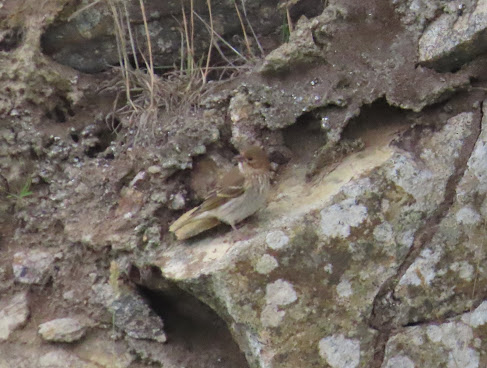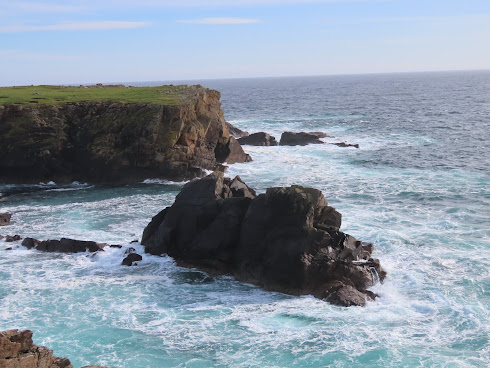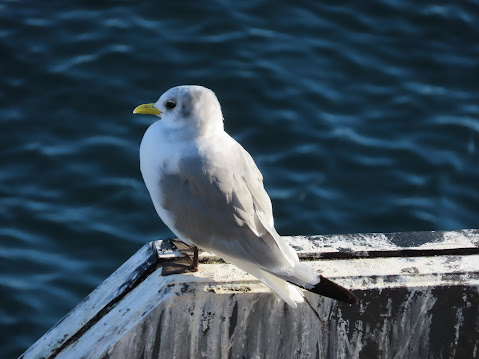In the early days of my holiday in Shetland, we were based in the north of Mainland, so it was inevitable that we would take a trip to one of the northerly islands, and today we went to Unst. This is the most northerly island in the UK, a rugged, bleak place with some outstanding scenery, and a few birds. After the decent haul of birds yesterday, today was a bit of a no-show, and we chased some birds which were fairly common, not really what I came to Shetland for.
The bird we went to Unst for was a PECTORAL SANDPIPER, yes a fairly decent bird, but one that's barely a scarcity. What was strange about the sighting was its location, in a field on the edge of a cliff, a strange habitat for a wader, you expect to see them on some scrape or lowland marsh. It had been found by a local birder, who was present, and showed it to us, even the natives are finding the paucity in birds difficult. It was with four DUNLIN, and I wager that all these waders have been blown in from America, the strong westerly winds making it very likely. It was a first record for me for Scotland, but that's about it.
The site of the pec sand, Lamba Ness, was actually more interesting, the landscape was strewn with crumbling buildings from the second world war and later, radar towers looking for bombers from Europe. What's even more interesting about this place is that its being touted to be the UKs first spaceport. Exciting yes, first port of call to the stars and everything. However it will mean more taming of our wilderness, more destruction of our our distant and remote lands. Sure not much wildlife is present on Unst, but with busy roads being built all the way from Mainland, lots of building work and lots of people visiting, it will be another UK place tamed into submission.
As we were leaving Lamba Ness, a small flock of TWITE crossed our path, and the tour guide, David, managed to pick out a single COMMON ROSEFINCH among them. The flock landed next to the minibus, and settled on the edge of a small quarry, giving good views. This was a great sighting, one so out of the blue, I mean who would have expected it, and just shows the birding skills of our guide.
From Lamba Ness we headed on to more gentle country, and to Norwick Beach, to see a LITTLE STINT, yeah a little stint, a fairly common wader anywhere at this time of year. As usual the beach was formed of a brilliant white sand, with turquoise water, empty of people, but also very cold. The LITTLE STINT was easy to find, being so much smaller than the other waders, and like a lot of small birds it made up for its size by its feistiness, chasing away the other waders which inhabited the beach. The most interesting thing about this sighting was that it was my first record of a little stint on a beach, you usually see them on some scrape or area of mud, and its also my first for Scotland.
Shetland beaches are rich in the smaller waders, as the quiet areas of sand allows for undisturbed feeding. RINGED PLOVERS, TURNSTONES, SANDERLINGS and DUNLIN were all around in decent numbers, running up and down the tide line. Pretty much all the quieter beaches held numbers of these birds, birds which I miss in the busy beaches of Suffolk, where they are all disturbed by the throngs of tourists.
Slightly off the birding topic we visited Skaw, the most northerly house in the UK, although it wasn't lived in except for some sheep in the front garden and there was little bird wise in the surrounding trees. Around the abandoned buildings were a couple of SHETLAND WRENS, a subspecies endemic to Shetland, slightly bigger and darker, which adds a new dimension to a common bird. With little tree growth they were found around, buildings, dry stone walls and rocky cliffs and were common enough.
Not a classic day really, the malaise in Autumn migration is not restricted to just Shetland, as throughout the country the birds weren't coming in. When the forces of nature are against you there's not really much you can do, with the constant strong westerlies blowing, what chance did we have. When even the local birders find it difficult going then there's nothing much I could do except enjoy the fact that I am on Shetland. There are worse things than a lack of rare birds.








No comments:
Post a Comment